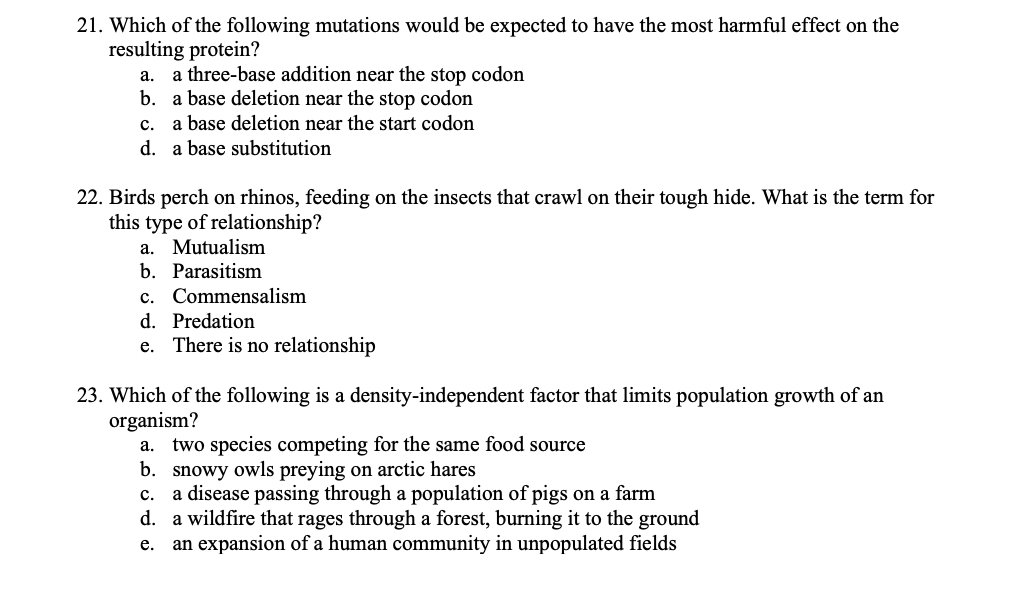21. Which of the following mutations would be expected to have the most harmful effect on the resulting protein? a. a three-base addition near the stop codon b. a base deletion near the stop codon c. a base deletion near the start codon d. a base substitution
21. Which of the following mutations would be expected to have the most harmful effect on the resulting protein? a. a three-base addition near the stop codon b. a base deletion near the stop codon c. a base deletion near the start codon d. a base substitution
Biology: The Dynamic Science (MindTap Course List)
4th Edition
ISBN:9781305389892
Author:Peter J. Russell, Paul E. Hertz, Beverly McMillan
Publisher:Peter J. Russell, Paul E. Hertz, Beverly McMillan
Chapter15: From Dna To Protein
Section: Chapter Questions
Problem 5TYK: Which of the following statements is false? a. GTP is an energy source during various stages of...
Related questions
Question
please answer all three please

Transcribed Image Text:21. Which of the following mutations would be expected to have the most harmful effect on the
resulting protein?
a three-base addition near the stop codon
b. a base deletion near the stop codon
а.
с.
a base deletion near the start codon
d. a base substitution
22. Birds perch on rhinos, feeding on the insects that crawl on their tough hide. What is the term for
this type of relationship?
a. Mutualism
b. Parasitism
c. Commensalism
d. Predation
e. There is no relationship
23. Which of the following is a density-independent factor that limits population growth of an
organism?
a. two species competing for the same food source
b. snowy owls preying on arctic hares
a disease passing through a population of pigs on a farm
d.
с.
a wildfire that rages through a forest, burning it to the ground
an expansion of a human community in unpopulated fields
е.
Expert Solution
This question has been solved!
Explore an expertly crafted, step-by-step solution for a thorough understanding of key concepts.
Step by step
Solved in 3 steps

Knowledge Booster
Learn more about
Need a deep-dive on the concept behind this application? Look no further. Learn more about this topic, biology and related others by exploring similar questions and additional content below.Recommended textbooks for you

Biology: The Dynamic Science (MindTap Course List)
Biology
ISBN:
9781305389892
Author:
Peter J. Russell, Paul E. Hertz, Beverly McMillan
Publisher:
Cengage Learning

Biology (MindTap Course List)
Biology
ISBN:
9781337392938
Author:
Eldra Solomon, Charles Martin, Diana W. Martin, Linda R. Berg
Publisher:
Cengage Learning

Anatomy & Physiology
Biology
ISBN:
9781938168130
Author:
Kelly A. Young, James A. Wise, Peter DeSaix, Dean H. Kruse, Brandon Poe, Eddie Johnson, Jody E. Johnson, Oksana Korol, J. Gordon Betts, Mark Womble
Publisher:
OpenStax College

Biology: The Dynamic Science (MindTap Course List)
Biology
ISBN:
9781305389892
Author:
Peter J. Russell, Paul E. Hertz, Beverly McMillan
Publisher:
Cengage Learning

Biology (MindTap Course List)
Biology
ISBN:
9781337392938
Author:
Eldra Solomon, Charles Martin, Diana W. Martin, Linda R. Berg
Publisher:
Cengage Learning

Anatomy & Physiology
Biology
ISBN:
9781938168130
Author:
Kelly A. Young, James A. Wise, Peter DeSaix, Dean H. Kruse, Brandon Poe, Eddie Johnson, Jody E. Johnson, Oksana Korol, J. Gordon Betts, Mark Womble
Publisher:
OpenStax College

Biology 2e
Biology
ISBN:
9781947172517
Author:
Matthew Douglas, Jung Choi, Mary Ann Clark
Publisher:
OpenStax

Biology: The Unity and Diversity of Life (MindTap…
Biology
ISBN:
9781337408332
Author:
Cecie Starr, Ralph Taggart, Christine Evers, Lisa Starr
Publisher:
Cengage Learning
